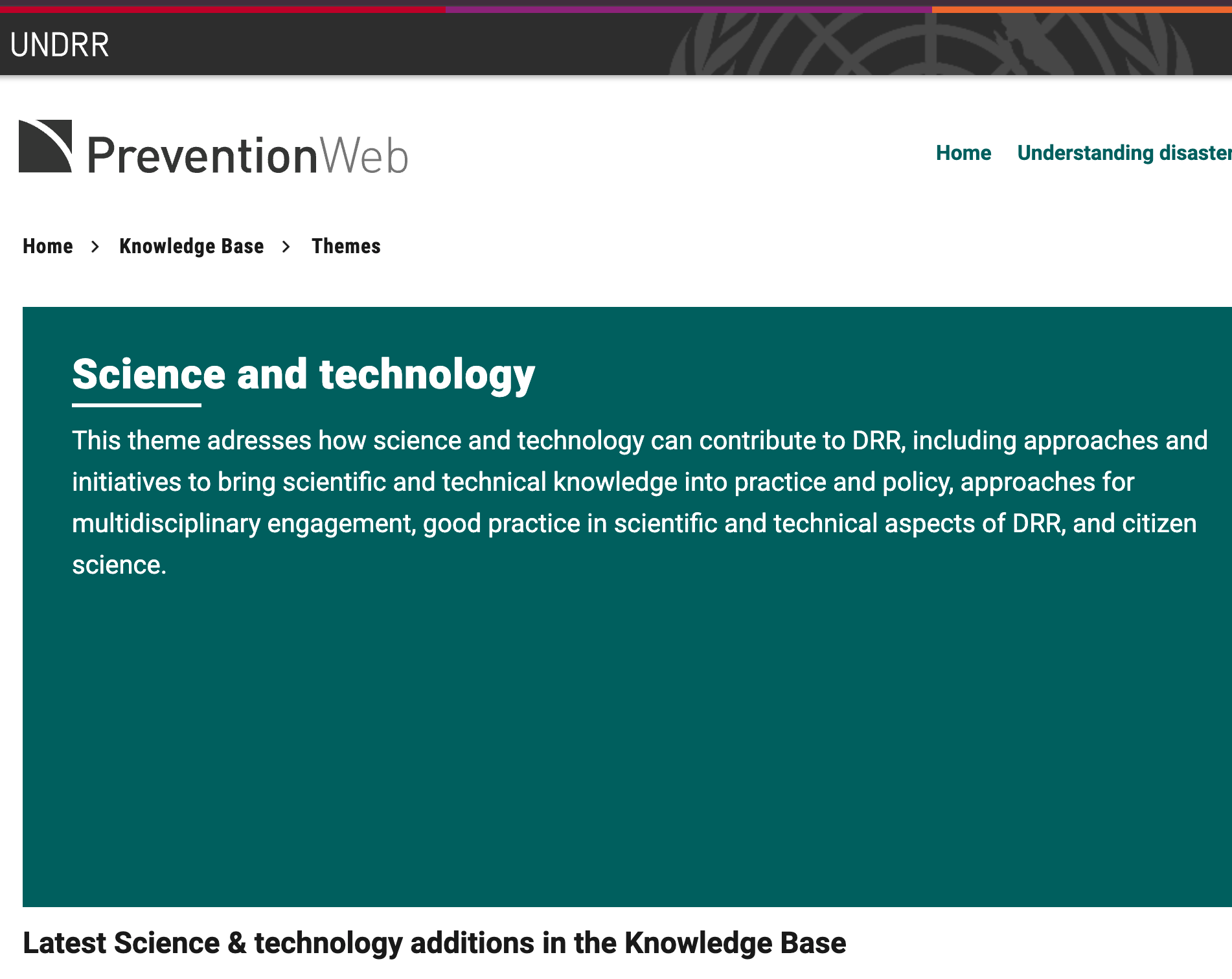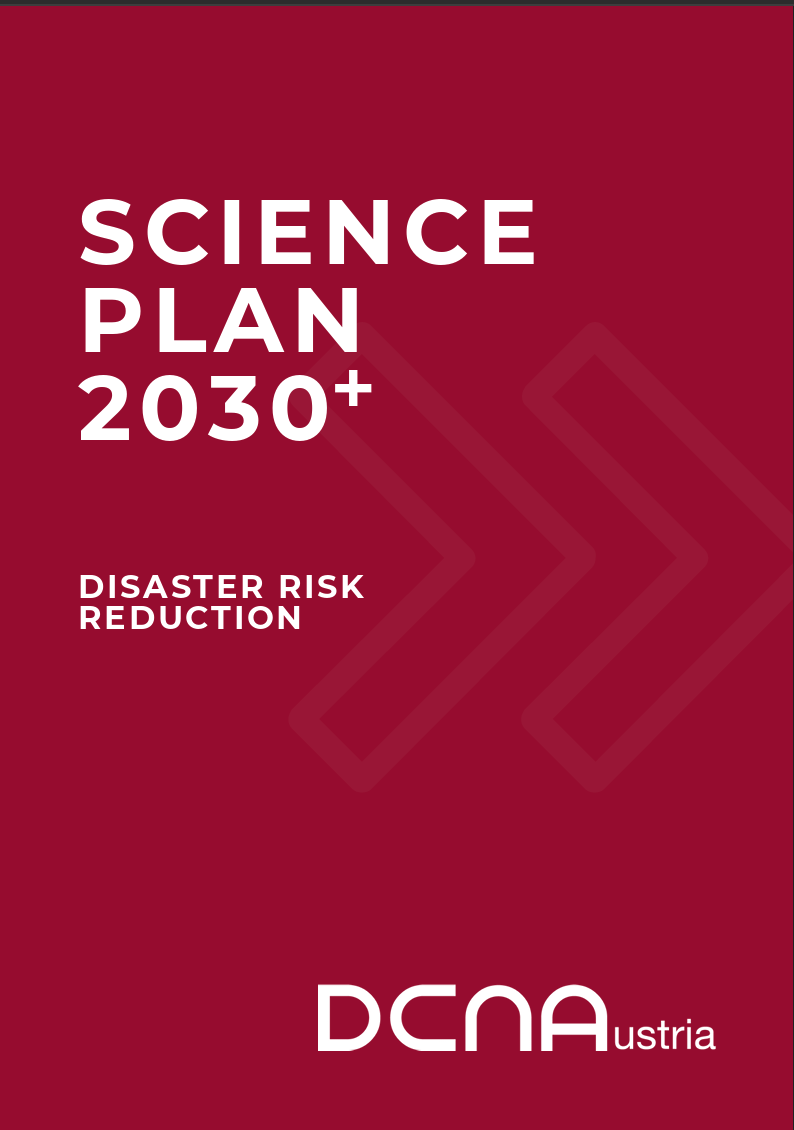Ciencia y tecnología
Science and Technology
- UNDRR. Link.
- GFDRR Innovation. Link
- APRU Multi-Hazards. Link.
- The science and technology roadmap to support the implementation of the Sendai Framework for Disaster Risk Reduction 2015-2030. Link.
- Prevention Web Science and Technology. Link.
- 30 innovations
- Disaster risk reduction and innovations. Progress in Disaster Science, 2019. Link.
- 30 Innovations linking disaster risk reduction with sustainable development goals. Link.
- 30 innovations for disaster risk reduction. Link.
- Applications of artificial intelligence for disaster management. Natural Hazards, 2020. Link.
Lecturas
Exploring the emerging evolution trends of disaster risk reduction research: a global scenario. International Journal of Environmental Science and Technology, 2021. Link.
Knowledge and Disaster Risk Reduction. The Routledge Handbook of Hazards and Disaster Risk Reduction. 2011. Link
Perspectives of Science and Technology in Disaster RiskReduction of Asia. 2016. International Journal of Disaster Risk Science. Link.
Three innovative approaches for managing disaster risks. Link.
2021 APRU Multi-Hazards Webinar Series: Health, Climate Change and Innovation in Disaster Risk Reduction. Link, link.
ADB and OECD. 2020. Leveraging Technology and Innovation for Disaster Risk Management and Financing. Link
Success, innovation and challenge: School safety and disaster education in South America and the Caribbean, 2020. Link.
IRDR Compilation 2010-2020: A Ten Year Science Quest for Disaster Risk Reduction. Link
The Integrated Research on Disaster Risk 2021 International Conference. Link.
A framework for global science in support of risk-informed sustainable development and planetary health. 2021. Link.
Disaster Risk Science: A Geographical Perspective and a Research Framework. 2020. Link
Building a global forum for natural hazard science. NPJ. 2025. Link
Videos
Inteligencia artificial en GRD
Lecturas
- Artificial intelligence for climate prediction of extremes: State of the art, challenges, and future perspectives. 2025. Link.
Herramientas
- Google Geospatial Reasoning. Link
- ESRI Geospatial AI platform. Link
Cursos en ciencia y tecnología en grd
- Risk-informed governance and innovative technology for disaster risk reduction and resilience. UNDRR. Link.
- Unit 1: Risk-Informed Governance for DRR and Resilience
- Unit 2: Science Technology and Government Innovation in Public Governance for DRR and Resilience
- Unit 3: Practical and Planned Application of Emerging Technology and Government Innovation for DRR and Resilience
- Unit 4: Implementation of Emerging Technologies and Government Innovation for DRR and Resilience
- Unit 5: Reflecting on and Planning for Monitoring and Evaluation (optional)
- Unit 6:Case Studies - Application of Technology for Reducing Disaster Risks
Libros de referencia internacionales
- The Routledge Handbook of Hazards and Disaster Risk Reduction. 2012. Link.
- The Routledge Handbook of Disaster Risk Reduction Including Climate Change Adaptation. 2017. Link.
- Crisis and Emergency Management: Theory and Practice, Second Edition. 2017. Link.
- Extreme Natural Hazards, Disaster Risks and Societal Implications. 2014. Link.
- Encyclopedia of Natural Hazards. 2013. Link.
- Encyclopedia of Natural Hazard Science. OUP. Link.
- Education for Sustainable Development and Disaster Risk Reduction. 2014. Link.
- Integrated Research on Disaster Risks. Springer. 2021. Link.
- Introduction to Catastrophe Risk Modelling. A Physics-based Approach. 2025. Link. Link
- Natural Hazards, Second Edition: Explanation and Integration. 2017. Link.
- Natural Hazards and Disasters. Fifth Ed. Hyndman. 2017. Link.
- Natural Catastrophe Risk Management and Modelling: A Practitioner’s Guide. Link
- The Role of Ecosystems in Disaster Risk Reduction. 2013. Link. ***
- Social Vulnerability to Disasters, Second Edition. 2013. Link.
- Systemic Risk: History, Measurement and Regulation. 2019. Link.
- Systemic Disaster Risk Handbook. 2021
- Sustainable Development and Disaster Risk Reduction. 2016. Link.
- Natural Climate Solutions Handbook: A Technical Guide for Assessing NatureBased Mitigation Opportunities in Countries. 2021. Link.
- The Invention of Disaster. Power and Knowledge in Discourses on Hazard and Vulnerability. Routledge. 2022. Link.
- Creating Resilient Futures. Integrating Disaster Risk Reduction, Sustainable Development Goals and Climate Change Adaptation Agendas. 2022. Springer. Link.
- Handbook on Climate Change and Disasters. 2023. Link.
- Disaster Risk Reduction for Resilience. Climate Change and Disaster Risk Adaptation. 2023. Link
- Física del caos en la predicción meteorológica. 2023. AEMET España. Link.
- Lecturas sobre conceptos
Institutos y organizaciones internacionales
- APRU – Association of Pacific Rim Universities. Link.
- Center for Emergency Management and Homeland Security. ASU. Link.
- Columbia Climate School. Link.
- DesignSafe CI. Link
- FAO Ciencia, tecnología e innovación. Link.
- GADRI – Global Aliance of Disaster Risk Institutes. Link.
- Global Assessment Repo. Link.
- Harvard Humanitarian Initiative. Link.
- Hazards & Vulnerability Research Institute. Link. Link.
- Integrated Research on Disaster Risk International Center of Excellence Vulnerability and Resilience Metrics. Link
- Integrated Research on Disaster Risk (IRDR). Link Link.
- International Science Council. Link.
- IRIDes – International Research Institute for Disaster Science. Link
- Natural Hazards Center. Link.
- CONVERGE. Link.
- NIED, Science for resilience. Japón. Link.
- Resilient America. Link
- Latinoamerica
- Redes UNDRR
- PreventionWeb community. Link.
- Plataformas de análisis de riesgos
- Sistemas de información de Colombia
- Consolidados de emergencia y desastres. Link.
- Corporación OSSO. Link.
- Sistema de Alerta Temprana de Medellín y el Valle de Aburrá (SIATA). Link.
- Departamento Administrativo del Sistema para la Prevención, Atención y Recuperación de Desastres de la Gobernación de Antioquia (DAPARD). Link.
- Sistema de Información Ambiental de Colombia (SIAC). Link.
- Sistema Integrado de Monitoreo Ambiental de Caldas (SIMAC). Link.
- FEWS Colombia. Sistemas de pronósticos hidrológicos y alerta temprana. Link
- DHIME: Consulta y Descarga de Datos Hidrometeorológicos, IDEAM. Link.
- Plataforma Observatorio Bahia de Cartagena. Link.
- Manejo de desastres
A Decade of the Sendai Framework for Disaster Risk Reduction – Envisioning the Road Ahead» on 26 September at UNESCO Headquarters, in Paris France, 2024
Revistas en gestión de riesgos
- Internacionales
- International Journal of Disaster Risk Reduction. Link.
- International Journal of Disaster Risk Science. Link.
- Natural Hazards. Link.
- Natural Hazards NPJ. Link
- Natural Hazards Review. Link.
- Natural Hazards and Earth System Sciences. Link.
- Environmental Science and Policy. Link.
- Environment: Science and Policy for Sustainable Development. Link.
- Progress in Disaster Science. Link.
- Safety Science. Link.
- Risk Analysis. Link.
- Risk, Hazards, & Crisis in Public Policy. Link.
- Advances in Natural and Technological Hazards Research. Link.
- Nature, Collection Natural Hazards. Link.
- Natural Hazard Center.
- Latinoamericanas
- Revista de Estudios Latinoamericanos sobre Reducción del Riesgo de Desastres REDER. Link.
- Colombianas
- Cuadernos de Geografía: Revista Colombiana de Geografía. Link.
- Boletín de Geología. Link.
- Earth Sciences Research Journal. Link.
- CT y F – Ciencia, Tecnologia y Futuro. Link.
- Geología Colombiana. Link.
- Ingenieria e Investigacion. Link.
- Revista Facultad de Ingenieria. Link.
- Revistas de divulgación Seguros Sura. Link.
- Revista DYNA. Link.
- Perspectiva Geográfica. Link.
- Legislación prospectiva. Link.
- Ranking de Revistas en GRD
Algunos investigadores Internacionales en DRR
Eventos internacionales
Riesgos y salud pública
- The Lancet Countdown: tracking progress on health and climate change. Link.
Programas institucionales asociados a la ciencia de los desastres
- Servicio Geológico Colombiano. Plan Estratégico del Conocimiento Geocientífico del Territorio Colombiano 2022 – 2032.Link.
- Plan Estratégico Nacional de Investigación Ambiental – PENIA. Link.
Ciencia y datos abiertos para DRR
InaSAFE is free software that produces realistic natural hazard impact scenarios for better planning. Link.
UNESCO. Multistakeholder Consultations on Open Science. Link.
Fifth Global Expert Forum for Producers and Users of Disaster-related Statistics. Link
Lecturas



